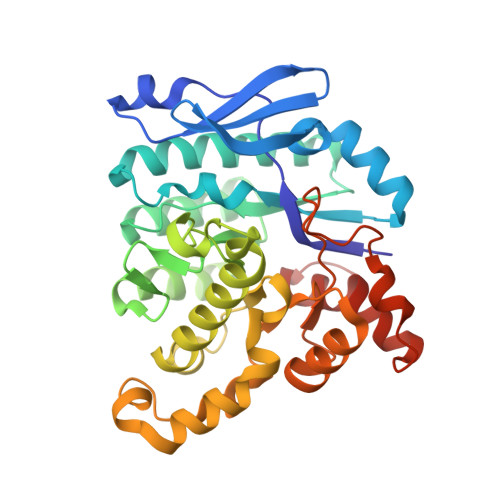The Crystal Structure of Human Alpha-Amino-Beta-Carboxymuconate-Epsilon-Semialdehyde Decarboxylase in Complex with 1,3-Dihydroxyacetonephosphate Suggests a Regulatory Link between Nad Synthesis and Glycolysis
Garavaglia, S., Perozzi, S., Galeazzi, L., Raffaelli, N., Rizzi, M.(2009) FEBS J 276: 6615
- PubMed: 19843166
- DOI: https://doi.org/10.1111/j.1742-4658.2009.07372.x
- Primary Citation of Related Structures:
2WM1 - PubMed Abstract:
The enzyme alpha-amino-beta-carboxymuconate-epsilon-semialdehyde decarboxylase (ACMSD) is a zinc-dependent amidohydrolase that participates in picolinic acid (PA), quinolinic acid (QA) and NAD homeostasis. Indeed, the enzyme stands at a branch point of the tryptophan to NAD pathway, and determines the final fate of the amino acid, i.e. transformation into PA, complete oxidation through the citric acid cycle, or conversion into NAD through QA synthesis. Both PA and QA are key players in a number of physiological and pathological conditions, mainly affecting the central nervous system. As their relative concentrations must be tightly controlled, modulation of ACMSD activity appears to be a promising prospect for the treatment of neurological disorders, including cerebral malaria. Here we report the 2.0 A resolution crystal structure of human ACMSD in complex with the glycolytic intermediate 1,3-dihydroxyacetonephosphate (DHAP), refined to an R-factor of 0.19. DHAP, which we discovered to be a potent enzyme inhibitor, resides in the ligand binding pocket with its phosphate moiety contacting the catalytically essential zinc ion through mediation of a solvent molecule. Arg47, Asp291 and Trp191 appear to be the key residues for DHAP recognition in human ACMSD. Ligand binding induces a significant conformational change affecting a strictly conserved Trp-Met couple, and we propose that these residues are involved in controlling ligand admission into ACMSD. Our data may be used for the design of inhibitors with potential medical interest, and suggest a regulatory link between de novo NAD biosynthesis and glycolysis.
Organizational Affiliation:
DiSCAFF Dipartimento di Scienze Chimiche, Alimentari, Farmaceutiche e Farmacologiche, University of Piemonte Orientale A. Avogadro, Novara, Italy.

















